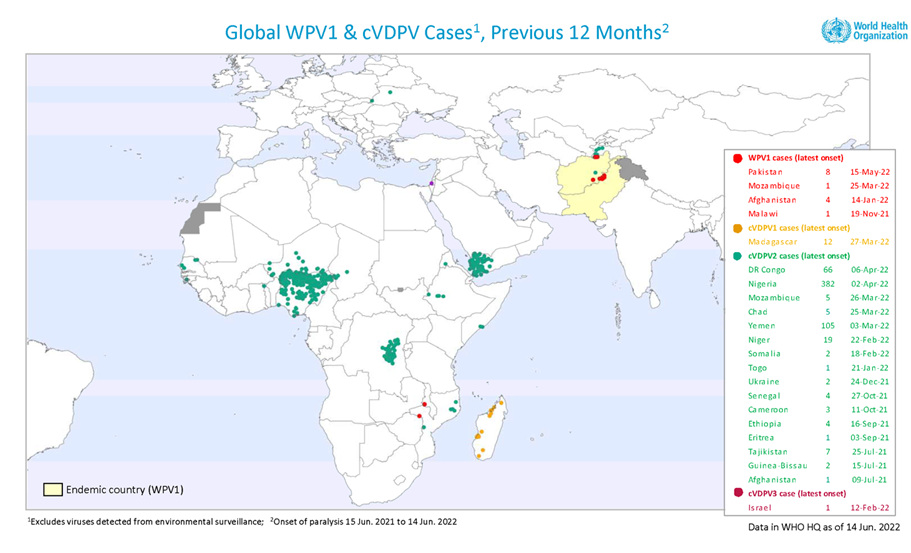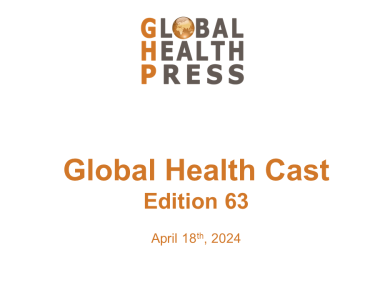The UK Heath Security Agency (UKHSA) has found poliovirus in sewage samples collected from the London Beckton Sewage Treatment Works. As part of routine surveillance, these detections occurred when an individual vaccinated overseas with the live oral polio vaccine (OPV) returned or traveled to the UK and briefly shed traces of a so-called vaccine-derived poliovirus (VDPV) in their feces, a rare genetically changed strain of the weakened poliovirus that was included in the oral polio vaccine (OPV). Investigations are underway after several closely related viruses were found in sewage samples taken between February and May. The VDPV has continued to evolve and is now classified as a vaccine-derived poliovirus type 2 (VDPV2), which on extremely rare occasions can cause serious illness, such as paralysis, in people who are not fully vaccinated.
The detection of a VDPV2 suggests it is likely there has been some spread between closely linked individuals in North and East London and that they are now shedding the type 2 poliovirus strain in their feces. The virus has only been detected in sewage samples and no associated cases of paralysis have been reported – but investigations will aim to establish if any community transmission is occurring.
The last case of wild polio contracted in the UK was confirmed in 1984. The UK was declared polio-free in 2003.
The WHO published a series of considerations regarding the risk of importation of wild poliovirus (WPV) and VDPV. There are 3 wild types of polioviruses (WPV), people need to be protected against all 3 types in order to prevent the disease. Wild type 2 (WPV2) was declared eradicated in 2015 and Type 3 (WPV3) in 2019; therefore, only Type 1 (WPV1) remains. The detection of WPV1 outside the last two endemic countries, Pakistan and Afghanistan, is of great concern and underscores the importance of prioritizing activities to detect and control polio.
Additionally, several countries in Africa and Asia have so called circulating-vaccine-derived poliovirus (cVDPV), which are VDPV isolates of poliovirus for which there is evidence of person-to-person transmission within a community that may arise especially in communities with low vaccination coverage.
Number of WPV1 and cVDPV in each country affected in the last 12 months.

The Polio IHR Emergency Committee unanimously agreed that the risk of international spread of poliovirus remains a Public Health Emergency of International Concern (PHEIC) and considered the following concluding factors:
- With the ongoing risk of WPV1 international spread, the outbreak of WPV1 in Pakistan where there have been 10 cases in the last 3 months must be contained; high-risk mobile populations in Pakistan such as migrants, nomads, displaced populations, particularly Afghan refugees represent a specific risk of international spread;
- the unpredictable situation in Afghanistan, with ongoing and deteriorating humanitarian crises including food insecurity and risk of financial collapse disrupting eradication activities;
- the detection of WPV1 in Malawi and Mozambique, particularly as the route from Pakistan to Africa remains unknown;
- the suboptimal immunization coverage obtained through recent rounds in southeastern Africa, meaning ongoing transmission could be occurring;
- the large pool of unvaccinated “zero dose” children in Afghanistan in formerly inaccessible areas in many provinces, while decreasing, still represent a major risk of re-introduction of WPV1 in those communities;
- the risk of international spread of cVDPV2 remains high with the actual ongoing cross-border spread including into newly infected countries;
- the explosive outbreak of cVDPV2 in northern Yemen, and ongoing high transmission in eastern Democratic Republic of the Congo and northern Nigeria, which have caused international spread to neighboring countries;
- the lack of timely high-quality responses in many countries;
- the ever-widening gap in population intestinal mucosal immunity in young children since the withdrawal of OPV2 in 2016 and consequently high concentration of zero dose children in certain areas;
- additionally, the number of countries in which immunization systems have been weakened or disrupted by conflict and complex emergencies poses a growing risk, leaving populations in these fragile states vulnerable to outbreaks of polio; and
- inaccessibility continues to be a major risk, particularly in several countries currently infected with cVDPV (Nigeria, Niger and Somalia) which all have sizable populations that have been unreached with polio vaccine for prolonged periods. (Detailed list with states infected with WPV1 and cVDPV)
As a risk mitigation plan, countries are recommended to develop a risk analysis and implement the necessary actions to mitigate the risk by achieving high vaccination coverage and maintaining a sensitive surveillance system and are urged to have an up-to-date outbreak response plan in place to be prepared to respond in a timely manner the occurrence of an imported WPV1 or vaccine-derived poliovirus case or to the emergence of vaccine-derived poliovirus. Because, as documented by the recent importation of WPV1 into Africa and the importation of the OPV2 virus into the UK in June. As long as poliovirus transmission is not interrupted worldwide, all countries remain at risk of polio importation. Maybe we should all check our polio vaccination status.
Relevant abbreviations
WPV: “wild poliovirus”, which exists in 3 types, named WPV1, WPV2, WPV3
OPV: oral polio vaccine (covering all 3 WPV types), a live vaccine with attenuated strains, that is shed via stool and may infect close contacts
VDPV: vaccine derived poliovirus, may in extremely rare cases cause polio in infected contacts.
cVDPV: circulating VDPV, which may cause explosive outbreaks specifically in undervaccinated populations.
By Dr. Simone Müschenborn-Koglin Contributing Editor, GHP

















